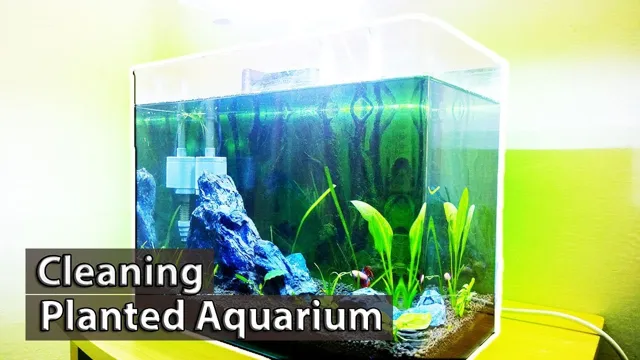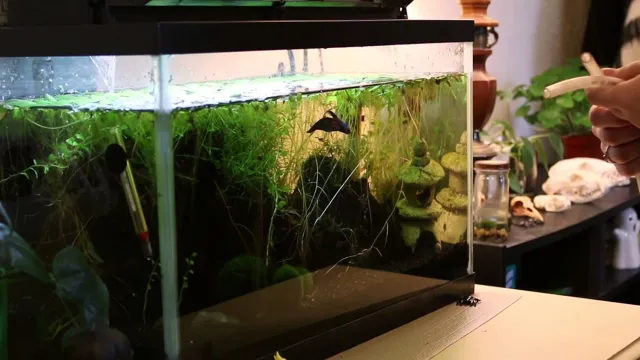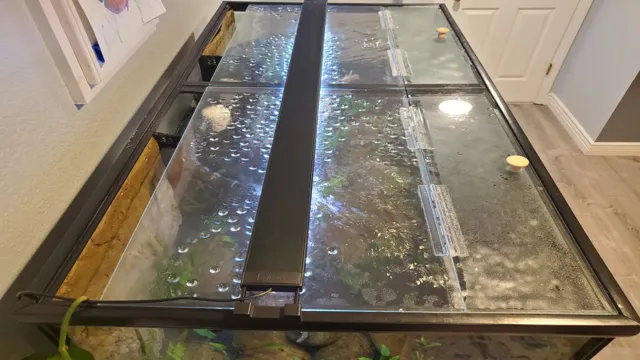How to Make Water More Acidic in Aquarium: Tips and Tricks.

Do you have trouble maintaining the proper pH balance in your aquarium? Are your fish suffering from stress or illness? One solution to your problem could be to acidify your aquarium water. By adjusting the pH level to a more acidic range, you can create a healthier environment for your aquatic pets. However, before you proceed, it is important to understand the potential risks and benefits of acidifying your water.
In this blog post, we will explore the science behind aquarium pH levels and provide tips for safely and effectively acidifying your aquarium water. Whether you are a beginner or an experienced aquarist, this information will help you keep your fish and plants thriving in their underwater world.
Understanding pH Levels
If you’re looking to make your aquarium water more acidic, there are a few things to consider. First, it’s important to understand pH levels. pH measures the acidity or alkalinity of a liquid on a scale of 0-14, with 7 being neutral, below 7 being acidic, and above 7 being alkaline.
Different species of fish and plants require different pH levels to thrive, so it’s important to research the needs of your specific aquarium inhabitants. To lower the pH and make the water more acidic, you can add natural materials like peat moss or driftwood to the tank. These materials release tannins which naturally lower the pH level.
Another option is to use a commercial pH lowering product, but be careful not to overdo it as sudden changes in pH can harm your fish and plants. Always test your water regularly and make gradual adjustments as needed.
What is pH?
pH levels pH is a measure of acidity or basicity of a solution. Although it might sound scientific, understanding pH levels is easy once you get the hang of it. The pH scale ranges from 0 to 14, with 7 being neutral.
Anything below 7 is considered acidic, and anything above 7 is basic or alkaline. The lower the pH level, the more acidic the substance, while the higher the pH level, the more alkaline the substance. For example, lemon juice has a pH of around 2, making it very acidic, while baking soda, with a pH of 9, is very alkaline.
The pH level of a solution affects how it behaves and interacts with other substances. Our body has its pH levels that need to be maintained for optimal health, and any imbalance can cause health problems. Understanding pH levels can help you make informed decisions about what substances to use, as well as what to avoid, to protect your body’s pH balance.

Ideal pH Range for Aquariums
As an aquarium hobbyist, understanding pH levels is crucial for the health of your fish, plants, and the entire aquatic ecosystem. pH represents the acidity or alkalinity of water on a scale of 0 to 14, with 7 being neutral, below 7 is acidic, and above 7 is alkaline. The ideal pH range for most freshwater aquariums is between
8 and 6, but it ultimately depends on the specific species of fish and plants in the tank. Some species may require a higher or lower pH level to thrive.
It’s essential to maintain a stable pH level to avoid fluctuations that can stress or harm your aquatic pets. Test the pH of your water regularly and make adjustments if necessary using pH buffers or additives. Remember, a healthy pH level is the foundation of a healthy aquarium, so make it a priority to monitor and maintain it regularly.
Methods for Acidifying Aquarium Water
If you have a fish species that needs acidic water in your aquarium, you may be wondering how to make the water more acidic. There are several methods to achieve this, but the most common one is to use peat moss. You can place peat moss in your aquarium’s filter or directly in the water, and it will release tannic acid to lower the pH level.
Another way is to use driftwood or almond leaves, which will also release tannins to acidify the water. However, keep in mind that these methods can also change the water’s color and create a tea-like appearance. If you want to avoid discoloration, you can try using commercial products, such as pH-lowering solutions or buffers, which are designed to adjust the water parameters to your desired range.
No matter which method you use, remember to test your water parameters regularly and make gradual adjustments to avoid shocking your fish. With these methods, you can successfully create an optimal living environment for your acidic water fish species.
Adding Acidic Substances
Acidifying aquarium water can seem daunting, but it’s not as complicated as it seems. One way to achieve this is by adding acidic substances to the water. You can use peat moss, which has a natural acidic property, or driftwood which releases tannins that lower the pH level.
A more manageable alternative would be to use an acid buffer solution, which is widely available in aquarium stores. However, it’s essential to be cautious as they tend to be strong and overdosing can be harmful to fish. It’s always best to start small, measure the pH levels and gradually increase dosage if necessary.
Don’t forget to monitor the water’s parameters regularly when using acidic substances as it can affect other levels such as hardness and alkalinity. Overall, adding acidic substances is a quick and straightforward method for acidifying aquarium water as long as it’s done responsibly and in moderation.
Using CO2 Injection
When it comes to acidifying aquarium water, there are different methods to explore. One of the popular techniques is using CO2 injection. This process involves introducing carbon dioxide into the water, which in turn lowers the pH levels.
The CO2 can be added through a diffuser or a reactor, and it’s important to monitor the concentration levels. While this method can be effective, it requires careful management to avoid harming the fish and plants in the aquarium. Additionally, there are other ways to naturally lower the pH levels, such as using peat moss or driftwood.
It’s recommended to research and consult with professionals before attempting to acidify aquarium water, to ensure the safety and health of all inhabitants.
Using an RO System
If you want to maintain a healthy aquarium, the water parameters are crucial. And one of the most important factors is the pH level. If the water is too alkaline or acidic, the fish can suffer.
One way to acidify the water is by using an RO system. Reverse Osmosis removes impurities, such as minerals, and reduces the hardness of the water. But how does it work? In simple terms, it works by forcing water through a semipermeable membrane that lets only pure water molecules pass through, leaving behind contaminants.
After that, it goes through a carbon filter that eliminates any residual chemicals or odor. The result is pure and soft water with a neutral pH. To acidify it, you can add pH-lowering substances, such as peat moss, driftwood, or commercially available acidifiers.
Just remember to test the water frequently to ensure the pH stays in the desired range. With an RO system, you can create a clean and safe environment for your fish and plants to thrive.
Tips for Maintaining Acidic Water
Maintaining an acidic environment in your aquarium can be a bit challenging but it’s not impossible. One of the most effective ways to make water more acidic is by using driftwood or peat to create natural tannins that lower the pH levels. You can also add some types of rocks like granite, quartz, and limestone that are known to naturally lower the pH levels.
Another important consideration is to avoid using alkaline chemicals like baking soda and limestone-based substrates as they can raise the pH levels and make the water less acidic. Additionally, regular water changes, proper filtration, and the correct size of the aquarium may also help maintain the acidic balance of the water. By conducting regular tests and making appropriate adjustments you can ensure your aquarium inhabitants thrive in the water you provide for them.
So take proper steps in order to make water more acidic and see the amazing results in the health of your aquatic pets.
Testing pH Regularly
Maintaining acidic water can be a challenge, especially if you’re new to owning a swimming pool or aquarium. One crucial element of keeping your water at the right acidity level is testing pH regularly. By doing this, you’ll be able to catch changes in pH before they become a big problem.
Your pH level should typically be between 2 and 8, which is slightly alkaline.
However, if your water is too acidic, it can cause irritation to swimmers and potentially damage your pool or aquarium equipment. One tip for maintaining proper acidity is to use pH increaser or decreaser chemicals as needed, which can easily be found at your local pool or aquarium supply store. Another way to help maintain acidity is to keep track of any changes in weather or water usage that may affect pH levels quickly.
By taking the time and effort to keep your pH balanced, you can ensure that your water stays crystal clear and enjoyable for all who use it.
Gradually Adjusting pH
Maintaining acidic water can be a challenging task, but it is essential for keeping aquatic life healthy. One way to maintain the pH level of acidic water is by gradually adjusting it. Sudden pH changes can be harmful to fish and other aquatic creatures.
You should test the water regularly to keep an eye on its pH level. If you notice that the pH level is too high or too low, make small adjustments of 0.2 or 0.
3 at a time until you reach the desired pH level. You can use acidic buffers such as peat moss or driftwood to maintain the pH of your aquarium. However, it is important to remember that these materials won’t lower the pH significantly if the water is too alkaline.
Besides, you should avoid overfeeding fish and clean the tank regularly to prevent the buildup of waste, which can also affect the water’s pH level. By maintaining the right pH level, you can ensure that your aquatic pets stay healthy and happy.
Conclusion
Well, unfortunately for those hoping for a punchline, there’s no clever way to put it: making water more acidic in an aquarium requires precise adjustments and careful monitoring. It may not be the most exciting process, but it’s crucial for ensuring a healthy and thriving aquatic ecosystem. So, if you’re looking to lower pH levels in your aquarium, remember to do your research, take things slow, and never underestimate the power of a well-maintained tank.
It may not be the recipe for the world’s most captivating joke, but it is the recipe for success in the world of aquariums.”
FAQs
Why is it important to adjust the acidity level in aquarium water?
Maintaining the proper pH level in an aquarium is essential for the health and wellbeing of aquatic life. When the water is too acidic or too alkaline, it can cause stress or even death in fish, plants, and invertebrates.
What are some natural ways to increase the acidity in aquarium water?
One natural way to lower the pH in an aquarium is to add driftwood or almond leaves, which release tannins into the water, lowering the pH level. Another way is to use peat moss or blackwater extract, which can acidify the water.
Can I use chemical additives to increase the acidity in aquarium water?
Yes, there are chemical additives specifically designed to adjust the pH level in aquarium water, such as pH-down products. It is important to follow the instructions carefully when using these products to avoid overdosing and harming aquatic life.
How often should I test the pH level in my aquarium?
It is recommended to test the pH level in an aquarium at least once a week to ensure it is within the appropriate range for the aquatic life in the tank. If the pH level is consistently off, more frequent testing may be necessary.
What is the ideal pH range for most aquarium fish?
Most aquarium fish prefer a pH range between 6.5 and 7.5, which is slightly acidic to neutral. However, there are some species that have specific pH requirements, so it is important to research the ideal range for the fish in your aquarium.
How can I maintain a stable pH level in my aquarium?
To maintain a stable pH level in an aquarium, it is important to perform regular water changes, avoid overfeeding and overcrowding, and monitor any changes in the water chemistry. Adding buffering substances like crushed coral or limestone to the tank can also help stabilize the pH.
What are some signs of a pH imbalance in an aquarium?
Signs of a pH imbalance in an aquarium can include stress or illness in fish, cloudy or discolored water, algae blooms, or poor plant growth. Regular monitoring and testing of the water chemistry can help prevent and address any pH imbalances.






